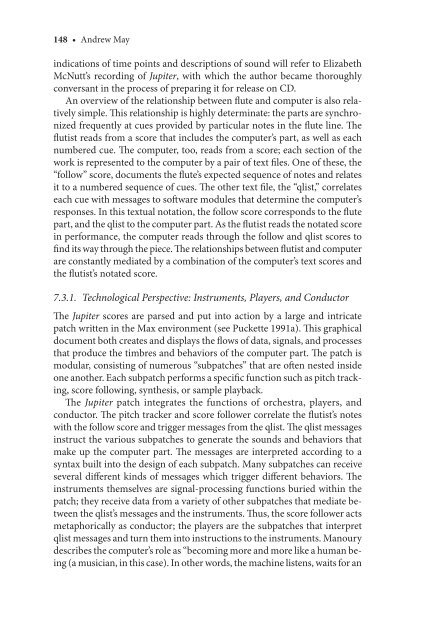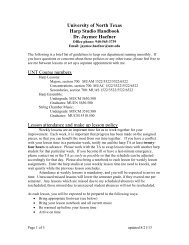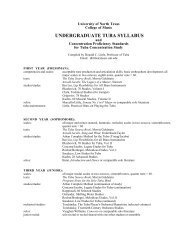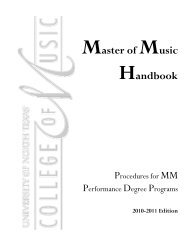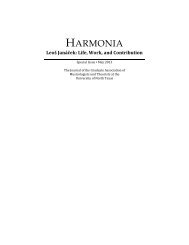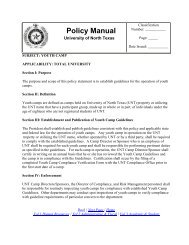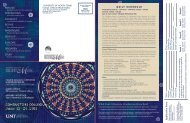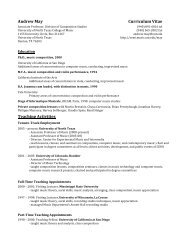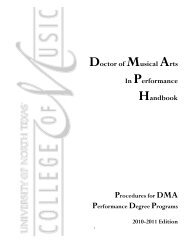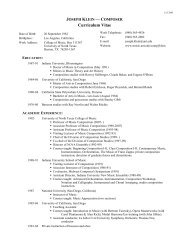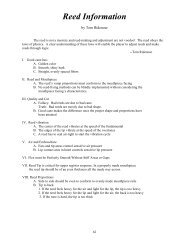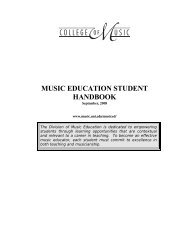7 Philippe Manoury's Jupiter1
7 Philippe Manoury's Jupiter1
7 Philippe Manoury's Jupiter1
Create successful ePaper yourself
Turn your PDF publications into a flip-book with our unique Google optimized e-Paper software.
148 • Andrew May<br />
indications of time points and descriptions of sound will refer to Elizabeth<br />
McNutt’s recording of Jupiter, with which the author became thoroughly<br />
conversant in the process of preparing it for release on CD.<br />
An overview of the relationship between fl ute and computer is also relatively<br />
simple. Th is relationship is highly determinate: the parts are synchronized<br />
frequently at cues provided by particular notes in the fl ute line. Th e<br />
fl utist reads from a score that includes the computer’s part, as well as each<br />
numbered cue. Th e computer, too, reads from a score; each section of the<br />
work is represented to the computer by a pair of text fi les. One of these, the<br />
“follow” score, documents the fl ute’s expected sequence of notes and relates<br />
it to a numbered sequence of cues. Th e other text fi le, the “qlist,” correlates<br />
each cue with messages to soft ware modules that determine the computer’s<br />
responses. In this textual notation, the follow score corresponds to the fl ute<br />
part, and the qlist to the computer part. As the fl utist reads the notated score<br />
in performance, the computer reads through the follow and qlist scores to<br />
fi nd its way through the piece. Th e relationships between fl utist and computer<br />
are constantly mediated by a combination of the computer’s text scores and<br />
the fl utist’s notated score.<br />
7.3.1. Technological Perspective: Instruments, Players, and Conductor<br />
Th e Jupiter scores are parsed and put into action by a large and intricate<br />
patch written in the Max environment (see Puckette 1991a). Th is graphical<br />
document both creates and displays the fl ows of data, signals, and processes<br />
that produce the timbres and behaviors of the computer part. Th e patch is<br />
modular, consisting of numerous “subpatches” that are oft en nested inside<br />
one another. Each subpatch performs a specifi c function such as pitch tracking,<br />
score following, synthesis, or sample playback.<br />
Th e Jupiter patch integrates the functions of orchestra, players, and<br />
conductor. Th e pitch tracker and score follower correlate the fl utist’s notes<br />
with the follow score and trigger messages from the qlist. Th e qlist messages<br />
instruct the various subpatches to generate the sounds and behaviors that<br />
make up the computer part. Th e messages are interpreted according to a<br />
syntax built into the design of each subpatch. Many subpatches can receive<br />
several diff erent kinds of messages which trigger diff erent behaviors. Th e<br />
instruments themselves are signal-processing functions buried within the<br />
patch; they receive data from a variety of other subpatches that mediate between<br />
the qlist’s messages and the instruments. Th us, the score follower acts<br />
metaphorically as conductor; the players are the subpatches that interpret<br />
qlist messages and turn them into instructions to the instruments. Manoury<br />
describes the computer’s role as “becoming more and more like a human being<br />
(a musician, in this case). In other words, the machine listens, waits for an<br />
Simoni_RT76294_C007.indd 148 9/22/2005 11:19:17 AM


